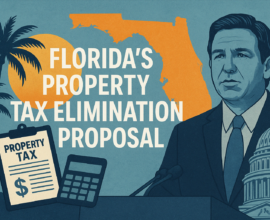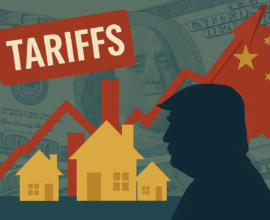Qualified Opportunity Zone Fund Program
The Qualified Opportunity Zone Fund Program allows real estate investors to defer federal taxation on recent capital gains and avoid taxes altogether on gains made through a Qualified Fund.
The Opportunity Zone Program has been around since 2017, but the program has been raising eyebrows since the Pandemic. This article explains the benefits of the program as well as some of the specific criteria for participating.
And, whatever you earn on that reinvested money you get to keep…tax free.
Definitions
Opportunity Zone – Each state has designated certain areas as “opportunity zones” as a means of encouraging investment and development in those areas. As you would expect, these zones are theoretically disadvantaged or underdeveloped…though there are some exceptions.
Qualified Fund – A fund specifically set up for investment in an opportunity zone. Buying property in an opportunity zone does not by itself provide tax benefits. The investment capital has to go into a Qualified Fund.
Qualified Fund Manager – Typically a team of professionals that manage the qualified fund, identifying and developing projects located within opportunity zones.
Benefits
Let’s start with the good stuff because the benefits available under the program are impressive. First and foremost, understand that there are really TWO distinct tax benefits. Let’s refer to GAIN #1 and GAIN #2. Don’t lose sight of the difference, or things will get confusing.
GAIN #1 – Existing Capital Gains
For Gain #1, we’re talking about the capital gains you have already made. More specifically, it would be the capital gains received within the last six (6) months. You can take those gains and reinvest them in a Qualified Opportunity Zone Fund. That will defer the tax on those capital gains until 2027. So, you have five (5) years in which you can make money on Uncle Sam’s money. Take the following illustration:
Example: Let’s say you sold a property for a profit of $500,000. You will probably owe 20% in capital gains tax, which would be $100,000. Under the Opportunity Zone program, Uncle Sam says this:
You can hold onto my $100,000 if you reinvest it in an Opportunity Zone. And, whatever you earn on that reinvested money you get to keep…tax free.
That is not a bad deal AT ALL. But, there is more.
GAIN #2 – Capital Gains from Quality Fund
Continuing with the example above, if you leave your $100,000 investment in the Qualified Fund for 10 years, you can take all the capital gains derived from that investment TAX FREE. Let that sink in.
Example: If you find a good Qualified Fund for your $100,000, you can probably expect a return rate of 10% to 15% per year. That will essentially double your investment in five (5) years. If so, by year five, your $100,000 investment will have grown to $200,000. Then, by year 10, your investment will be worth $300,000, which gives you a capital gain of $200,000 by the end of the 10-year cycle.
You will pay exactly zero taxes on that $200,000 gain.
That is the real charm of the Opportunity Zone program. The tax deferral on Gain #1 is very nice. In fact, it works even better than a 1031 Exchange, as discussed below. But, the tax-free aspect of Gain #2 is unbeatable.
To get the tax advantages, you have to invest “qualified capital gains.”
Who Can Be an “Investor” in the Opportunity Zone Program?
Ultimately, this federal program is open to ALL investors, but here are some specifics.
The investor can be either an individual or an entity. Many of you wisely hold your investments in an LLC or trust (maybe even a REIT). That’s no problem. You may want to make your Opportunity Zone investment in the name of the same LLC or trust…or maybe not. You may have the option.
The main question is: “Who is the taxpayer?” If your investment vehicle is “pass-through,” you are the “taxpayer.” In that case, you have the option to make the investment in the Qualified Fund with the same investment vehicle, or you can make the investment in your personal name. Either way, you will get the tax benefits.
By contrast, if your investment vehicle is taxed as a C-corp, then that entity is itself the “taxpayer.” In that case, you should use your entity as the investor in the Qualified Fund.
Caveat: Qualified funds are privately owned and managed, and some of them impose restrictions. One common restriction is that you be an “accredited investor,” as defined in the tax code. That is not a requirement imposed by the IRS, but you may find it is a criterion imposed by some fund managers.
What Kind of Money Qualifies for the Opportunity Zone Program?
To get the tax advantages, you have to invest “qualified capital gains.” So, it is not just any kind of money that can be invested in a Qualified Fund. So, for example, if you have put away some savings from your salary, that money will not qualify for the tax benefits even if you put it in a Qualified Fund. The money has to come from “capital gains.”
However, for purposes of a Qualified Fund, it is not only the proceeds from the sale of real estate that qualify as “capital gains.” All of the following are considered capital gains:
- Sale of Real Estate
- Sale of stocks and bonds
- Sale of shares in a corporation
- Sale of a partnership interest
- Sale of cryptocurrency
- Sale of REIT
- Sale of land
- Sale of machinery
- Sale of timber and other natural resources
- Sale of unharvested crops and livestock
- Gains from leaseholds (at least one year old)
As long as the funds you invest fall under one of the categories above, you can invest in a Qualified Fund and get the great tax benefits of the program. That is one advantage of a Qualified Fund over the more traditional 1031 exchange.
The projects should bring a benefit to the community, but this isn’t charity work. You can expect a good Qualified Fund to turn a tidy profit.
What Projects Are Available?
According to the IRS: “Opportunity Zones are an economic development tool that allows people to invest in distressed areas in the United States. Their purpose is to spur economic growth and job creation in low-income communities while providing tax benefits to investors.”
The legislation passed with bipartisan support. Keeping the purpose of the legislation in mind, Qualified Funds are required to focus on particular kinds of projects. Here are some of the guidelines.
New Construction
Projects must be brand new construction or a “substantial rehabilitation.” To be substantially rehabilitated, the Qualified Fund has to put more money into improving the property than it did to purchase it.
Beneficial to the Community
Qualified Funds are generally expected to invest in projects that create jobs or otherwise benefit the local residents, such as the following:
- Affordable Housing
- Community Revitalization
- Economic Development
- Infrastructure Investment
- Mixed-use Development
- Multifamily Residential
- Renewable Energy Investment
- Single Family Residential
- Small Businesses
- Workforce Housing
Profitability
The projects should bring a benefit to the community, but this isn’t charity work. You can expect a good Qualified Fund to turn a tidy profit.
And investors not only receive the tax-free capital gains from the projects, but they also participate in the yearly cash flow.
So, after 10 years, you will get your money out without triggering any tax liability at all. No endless hamster wheel of reinvesting.
Opportunity Zones Verses 1031 Exchanges
Most real estate investors are used to, and comfortable with, 1031 Exchanges as a way to defer taxation on capital gains. Opportunity Zones offer the same benefits and then some.
Commonalities
Both Opportunity Zones and 1031 Exchanges incentivize investors to reinvest their capital gains by offering deferred taxation. There are, however, important differences between the two programs.
Tax Savings
1031 Exchange – Indefinite Deferral
As an investor, when you sell a piece of real estate, you can take the initial investment money plus the profit and reinvest both amounts in another property of equal or greater value. You can defer taxation on the gains by continuing this practice indefinitely or until death. The natural effect of this program is that you will roll your money into increasingly expensive pieces of property, which is a way of growing the asset. That isn’t bad, but you will eventually have to “pay the piper.” And, in the meantime, you are stuck reinvesting over and over. You won’t be able to get your hands on any of that money unless you pay the taxes.
Qualified Fund – Deferral plus Forgiveness
Like 1031 Exchanges, Qualified Funds also provide tax deferral on capital gains. One major difference, though, is that you will not have to continue rolling the money over into new projects indefinitely to escape the capital gains tax.
Under the Opportunity Zone program, the tax due on the money invested as Gain #1 will have to be paid in 2027. So, the ride does come to an end on Gain #1.
However, the same is not true for the capital gains you will make through investment in the Qualified Fund (i.e. Gain #2). Your Gain #2 will be tax free as long as you keep the money in the Qualified Fund for at least 10 years.
So, after 10 years, you will get your money out without triggering any tax liability at all. No endless hamster wheel of reinvesting.
A Qualified Fund is likely to bring some measure of diversification to your investment.
Liquidity; Original Principal
This is another advantage to the Opportunity Zone program.
1031 Exchange – All or nothing
When you roll your money into a 1031 Exchange, you have to invest all the money you get back from the last sale – i.e. both the initial investment and the capital gains. That is why you will end up buying increasingly expensive replacement properties. If you don’t, you will have to pay taxes on any money not reinvested.
Qualified Fund – Free up the original principal
With a Qualified Fund, there is no requirement to roll over the original capital investment. If you prefer, you could take your purchase money out and just reinvest the capital gains.
1031 Example: Investor purchased a home for $300,000 and, two years later, sold it for $500,000. If the investor does a 1031 Exchange, with full tax deferral, the replacement property has to be worth $500,000 or more.
Qualified Fund Example: Investor purchased a home for $300,000 and, two years later, sold it for $500,000. If they go with a Qualified Fund, the initial $300,000 used to purchase the property can be held out without any tax repercussions. The investor can put just the $200,000 capital gain into the Qualified Fund. Then, let’s say their $200,000 in the Qualified Fund generates a gain of $400,000. After 10 years, the investor can take all the money out of the Qualified Fund (i.e. $600,000) tax free.
Deadlines
1031 Exchange – 45 days and 180 days
With a 1031 Exchange, the rule is that there must be an “exchange” of Property A for Property B. Both sale and purchase have to go together.
- You have 45 days from the date you sell Property A to identify a potential Property B.
- The exchange must be completed no later than 180 days after the sale of Property A, or within 180 days of the due date to file your taxes (with extensions), whichever comes first.
Qualified Fund – 180 days
The basic rule is that the capital gains must be placed in a Qualified Fund within 180 days of the sale of the asset. There are some exceptions, all of which provide additional time for reinvestment.
An investor that misses the 45-day deadline for a 1031 Exchange can still salvage the tax planning by placing the money in a Qualified Fund instead.
Control of Funds
1031 Exchange – Qualified Intermediary
One of the major pitfalls with a 1031 Exchange is that you can never be in control of the funds from the sale of Property A prior to purchase of Property B. So, you have to use a Qualified Intermediary. Failing to do so can easily disqualify the entire transaction and lead to penalties.
Qualified Fund – Relaxed Rule
On the other hand, investors in a Qualified Fund are not subject to any “control” restrictions. As long as your capital gains are placed in a Qualified Fund within 180 days (or more if an exception applies), your tax benefits will be preserved. That gives you the ability to use the money in the interim if you choose.
Miscellaneous Differences
There is no “like-kind” requirement when investing in a Qualified Fund since the transaction is not an “exchange.”
Also, when investing in a Qualified Fund, the funds can be any kind of capital gains or 1231 gains. With a 1031 Exchange, the only money that can be reinvested is the original principal and capital gains from Property A.
Lastly, a Qualified Fund is likely to bring some measure of diversification to your investment. Most Qualified Funds are large enough to hold more than one project, some of which may not be real estate developments. That diversification potentially reduces risk.
Conclusion
Objectively speaking, the Opportunity Zone program does seem to have important advantages over a traditional 1031 Exchange, but that is not to say it is for everyone.
Some investors enjoy the “hands-on” aspect of developing one project, selling, and reinvesting in another. 1031 Exchanges are perfect for them because they enjoy the endeavor. For many investors, though, the Opportunity Zone program is an absolute jewel.
There is a bill pending in Congress to extend the Opportunity Zone program. If that happens, I will let you know. There are no guarantees, though, so you may want to get in while you can.
Contact Jeff Harrington at Harrington Legal Alliance for information on specific Qualified Funds available in your area and/or for more information on the Opportunity Zone program.








